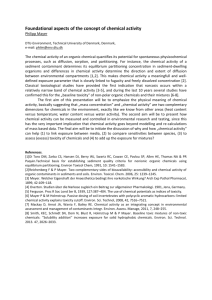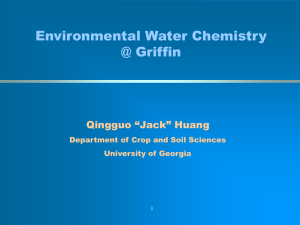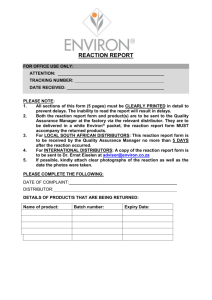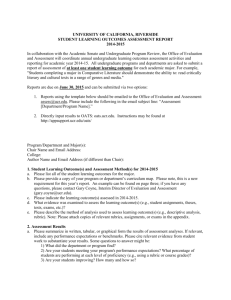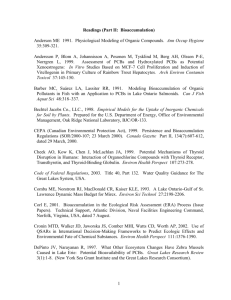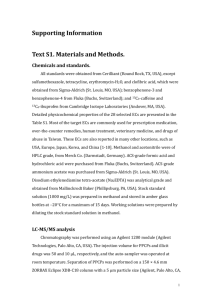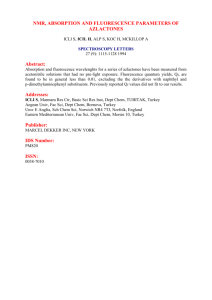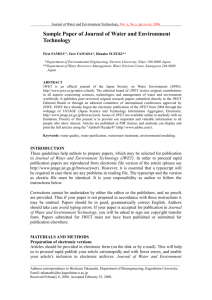How reliable monitoring tool can be
advertisement
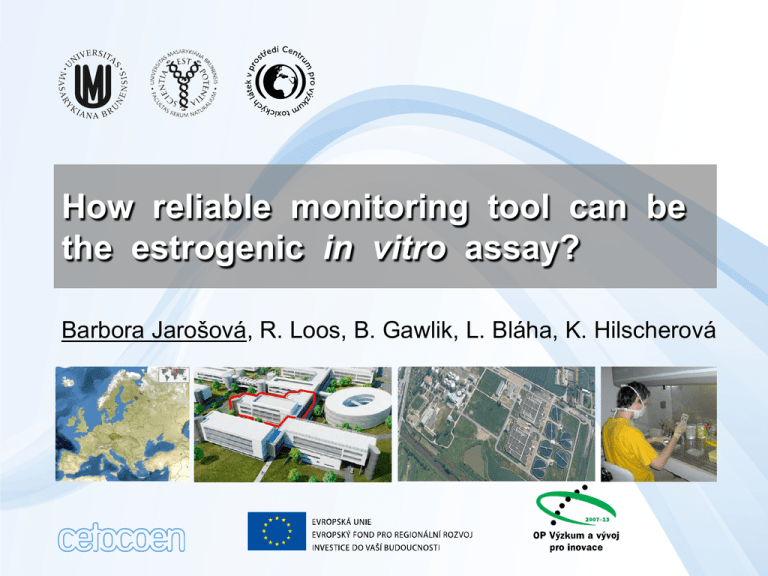
How reliable monitoring tool can be the estrogenic in vitro assay? Barbora Jarošová, R. Loos, B. Gawlik, L. Bláha, K. Hilscherová Introduction WFD EQSs – limits for good status of waters NP = 0.3 μg/L (Annual Average) E2 = 0.4 ng/L (Annual Average) EE2 = 0.035 ng/L (Annual Average) Introduction In vitro bioassay (e.g. MVLN cells) Results in [ng/L EEQ] Potential relative to E2 Introduction - in vitro assay as risk assessment tool ? in vitro 10 in vivo 1 0.1 0.01 0.001 0.0001 0.00001 E1 E2 E3 EE2 Nonylphenol Sampling sites 91 EU WWTPs Effluents JRC EC Ispra 5 EU laboratories 16 EU countries Western and Central EU Domestic / Industrial / Rain waters Activated sludge treatment CY Methods 160 polar organic chemicals 20 inorganic trace elements Methods Estrogenity of 75 samples analyzed by MVLN reporter gene bioassay Glass fibre filtration Extracts dilution (6 conc.) (MeOH) MCF – 7 (MVLN bioassay) Results – estrogenity - MUNICIPAL WWTPs 16 out of 48 MUNICIPAL WWTPs showed EEQ > LOD 0.5 ng/L. Results – INDUSTRIAL and unknown WWTPs 5 out of 12 INDUSTRIAL WWTPs showed EEQ > LOD 0.5 ng/L. Cytotoxicity Discussion EEQs ̴ well comparable to other EU studies Aerni et al. 2004 Anal. Bioanal. Chem. 378:688-696 53 30 EU This study (N 75) Cargouet et al. 2004 Sci. Total. Environ. 324:55-66 Switzerland (N 5) 25 Sweden (N 20) ng / L EEQ France (N 4) 20 Korner et al. 2001 Environ. Toxicol. Chem. 20:2142-2151 Germany (N 16) Netherlands (N 10) 15 Netherlands Ind. (N 3) Germany Ind. (N 2) Vethaak et al. 2005 Chemosphere 59: 511-524 10 5 0 Median Average Max. Discussion – Comparison with chemical analyses ? MVLN Spearman Correl. Sweeters Pharm. Silox.Musks OPFRs PCPs Benzotriazoles Vet.Antib. PFSs Nitrophenols Pest. Anorg. Sweeters Pharm. 0.52 Silox.,Musks 0.31 0.38 OPFRs 0.12 0.33 0.34 PCPs 0.17 0.31 0.24 0.22 Benzotriazoles 0.05 0.24 0.01 0.05 0.21 Vet.Antib. 0.14 -0.22 -0.03 0.13 -0.21 0.42 PFSs 0.06 -0.08 -0.18 0.11 -0.08 0.04 0.32 Nitrophenols 0.12 0.06 -0.03 -0.14 0.07 -0.01 0.02 -0.31 Pest. 0.08 0.11 0.06 0.09 0.05 0.22 0.21 0.10 -0.18 Anorg. -0.26 -0.39 -0.35 -0.15 -0.16 -0.16 -0.22 -0.19 0.02 EEQ 0.11 0.03 -0.16 -0.19 -0.14 -0.08 0.14 -0.17 -0.07 -0.06 -0.08 0.10 Discussion – Comparison with chemical analyses MVLN NO But E1, E2, EE2 LOQ was 10 ng/L and no sample > LOQ Discussion What caused in vitro estrogenity in other EU WWTP effluents? > 90 % Desbrow et al. 1998 Environ. Sci. Technol. 34:1548–1558 Korner et al. 2001 Environ. Toxicol. Chem. 20:2142-2151 Thomas et al. 2002 Environ. Toxicol. Chem. 21:1456 Houtman et al. 2004 Environ. Sci. Technol. 38(23):6415-23 Aerni et al. 2004 Anal. Bioanal. Chem. 378:688-696 … Cargouet et al. 2004 Sci. Total. Environ. 324:55-66 … 1 Nonylphenol (NP) > 100 µg/L ~ main cause < 1 µg/L ~ less than 1% UK 95%ile: 0.49 µg/L 1 17 EU WWTPs: 0.05 -1.31 µg/L2 e.g. Sole et al. 2000 Environ. Sci. Technol. 34:5076-5083 (289 µg/L) UK WIR 2012 report, 2012/7/5 http://www.ukwir.org 2 Johnson et al. 2005 Water Research 39, 47–58 3 Kawanishi et al. 2004 Environmental Science & Technology 23, 6424 All other Exceptions: e.g. Kanzaki River in Japan3 (Genistein) Discussion Is there any stable ratio of major steroidal estrogens in WWTPs effluents ? Median of reviewed ratios 100 90 4% 17% 80 70 56% % 60 10% 50 40 30 E1 % E2 % E3 % EE2 % 20 10 0 E1 E2 E3 EE2 Comparison with: Mie`ge et al. 2009a Environ. Pollut. 57:1721–1726 Discussion In vitro potentials 1.8 YES (N 6) 1.6 E-screen (N 1) 1.4 ER-calux (N4) 1.2 MVLN (N4) 1 This study 0.8 0.6 0.4 0.01 0.003 0.2 0 E1 E2 E3 EE2 Aerni et al. 2004 Anal. Bioanal. Chem. 378:688-696 Avberšek et al. 2011 Sci. Total. Environ. 409(23):5069-75 Furuichi et al. 2004. Water Res. 38(20):4491-501 Gutendorf and Westendorf 2001 Toxicology 166(1-2):79-89 Houtman et al. 2004 Environ. Sci. Technol. 38(23):6415-23 Korner et al. 2001 Environ. Toxicol. Chem. 20:2142-2151 Legler et al. 2002 Environ. Sci. Technol .36(20):4410-5 Metcalfe et al. 2001 in Caldwell et al. 2012. Environ Toxicol Chem. 1396-406 Pawlowski et al. 2004 Toxicol. In Vitro. 18(1):129-38 Rutishauser et al. 2004 Environ. Toxicol. Chem. 23(4):857-64 Routledge 1997 in Caldwell et al. 2012. Environ Toxicol Chem. Snyder et al. 2001 Environ. Sci. Technol. 35(18):3620-5 Sonneveld et al. 2006 Toxicol. Sci. 89(1):173-87 Svenson, Allard 2003 Water Res. 37(18):4433-43 Van den Belt et al. 2004 Aquat. Toxicol. 66(2):183-95 Discussion In vivo derived PNECs 1;2;3 PNECE1 6 ng/L PNECE2 2 ng/L PNECE3 60 ng/L PNECEE2 0.1 ng/L … 1 Caldwell et al. 2012 Environ. Toxicol. Chem. 31(6):1396-406 2 UK Environment Agency, Technical Report, Young et al. 2004 3 Holbech et al. 2006 Comp Biochem. Physiol. C Toxicol. Pharmacol. 144(1):57-66 Discussion Estimation of probable conc. of E1, E2, E3 and EE2 : Example: Total EEQ (E2 equiv.)…………….……….....……..2 ng/L E1 ratio…………………………………………….. 19 - 99 % E1 (E2 equiv) .........from.......0.20 x 2 = 0.38 ng/L ...………to…....0.99 x 2 = 1.98 ng/L E1 relative potency to E2…………...………….…..0.13 E1 conc. …………from... 0.38 / 0.13 = 2.9 ng/L ……………to……..1.8 / 0.13 = 15.2 ng/L PNECE1 6 ng/L might have been exceeded What if steroidal estrogens responsible only for 50 % ? Discussion Estimation of probable conc. of E1, E2, E3 and EE2 : Example: Total EEQ (E2 equiv.)…………….………………..2 ng/L E1 ratio……………………………………….. 19 - 99 % E1 (E2 equiv) .....from......0.20 x 2 = 0.38 ng/L ...…to…....0.99 x 2 = 1.98 ng/L E1 relative potency to E2…………...………….…..0.13 E1 conc. ……from…. 0.38 / 0.13 = 2.9 ng/L ……to…….1.8 / 0.13 = 15.2 ng/L E2 ratio……………………………………...0.5 - 55 % E2 (E2 equiv) ...from......0.005 x 2 = 0.01 ng/L ……to…....0.55 x 2 = 1.11 ng/L E2 relative potency to E2…………...…………..1 E2 conc. ………...……from…….. 0.01 ng/L …………….…to……..1.1 ng/L PNECE1 6 ng/L PNECE2 2 ng/L E3 ratio………………………………………...0.5 - 72 % E3 (E2 equiv) .....from.....0.005 x 2 = 0.01 ng/L ………to…....0.72 x 2 = 1.44 ng/L E3 relative potency to E2…………...……………...0.11 E3 conc. …….from…0.01 / 0.11 = 0.9 ng/L ...……to…..1.44 / 0.11 13.6 ng/L EE2 ratio……………………………………...0.2 - 19 % EE2 (E2 equiv) ..from. 0.002 x 2 = 0.004 ng/L ………to…....0.19 x 2 = 0.38 ng/L EE2 relative potency to E2…………...…………..1.09 EE2 con. . from…0.004 / 1.09 = 0.004 ng/L ….…to…….. 0.38 / 1.09 = 0.35 ng/L PNECE3 60 ng/L PNECEE2 0.1 ng/L Discussion Worst case: If steroidal estrogens (SE) responsible for measured EEQs and If actual ratio of SE was similar to any of the reported values (27 WWTPs) than: max. 25 out of 75 EU WWTPs effluents exceeded any of PNEC(E1, E2, E3, EE2) (max. 33% of tested samples, EEQ > 0.6 ng/L) Is the worst case scenario realistic ? (municipal vs. industrial WWTPs) Most frequently exceeded PNECEE2 and PNECE1 Dilution in river! Conclusions – in vitro assay as risk assessment tool ? In vitro EEQ ≠ In vivo EEQ In vitro assays estimation of concentrations of responsible compounds (steroidal estrogens) if well determined in vitro potencies range of ratios of responsible compounds Estimated concentrations – can be compared to PNECs (in vivo based) Conclusions WFD EQS – limit for good status of waters NP = 0.3 μg/L (Annual Average) E2 = 0.4 ng/L (Annual Average) EE2 = 0.035 ng/L (Annual Average) Estimated concentrations – can be compared to EQSs Conclusions Determination of negative samples by in vitro assay Comparison of calculated SE concentration with SE modeled concentrations Acknowledgment • Project CETOCOEN (CZ.1.05/2.1.00/01.0001) from the European Regional Development Fund • JRC EC Ispra, Italy • John P. Giesy, Department of Biomedical Veterinary Sciences and Toxicology Centre, University of Saskatchewan, Saskatoon, Saskatchewan, Canada • RECETOX, Masaryk University, Brno, Czech Republic Thank you for your attention jarosova@recetox.muni.cz References (not previously cited in presentation) Baronti et al. 2000 Environ. Sci. Technol. 34:5059–5066 107 Björkblom et al. 2008 Chemosphere 73:1064–1070 Caldwell et al. 2012 Environ. Toxicol. Chem.. 1396-406 Claraa et al. 2005 Water Res. 39:97–106 Labadie, Budzinski 2005 Environ. Sci. Technol. 39(14):5113-20 Legler et al. 2002. Environ. Sci. Technol. 36(20):4410-5 Muller et al. 2008 Environ. Toxicol. Chem. 27(8):1649-58 Pothitou, Voutsa 2008 Chemosphere 73(11):1716-23 Thomas et al. 2007 J. Environ. Monit. 9(12):1410-8

